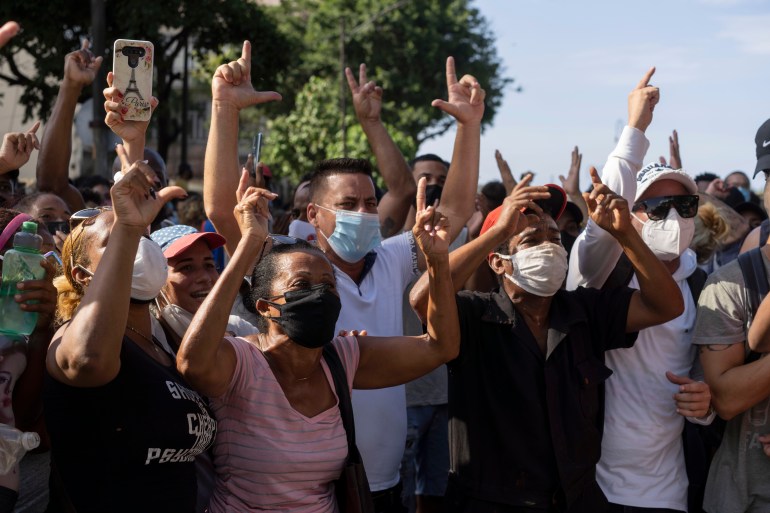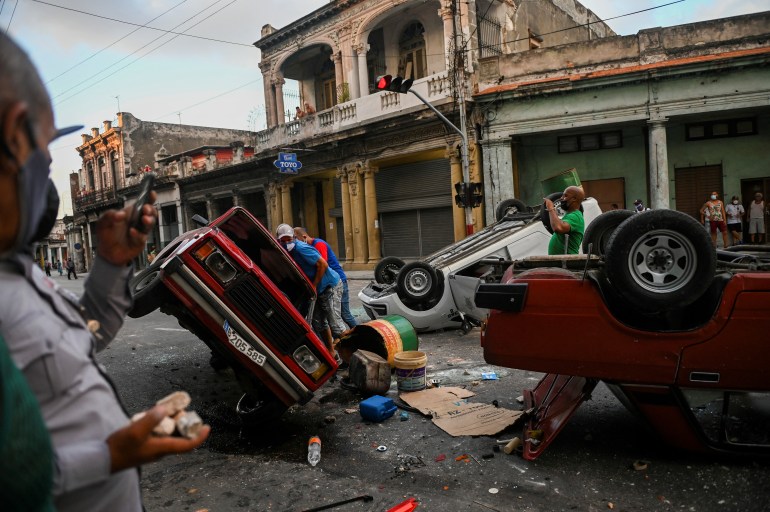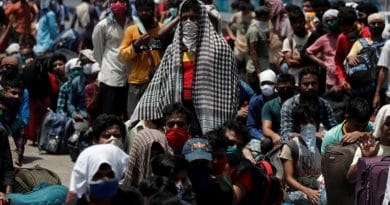Why Cubans took to the streets in all-but-unheard-of protests | Coronavirus pandemic News
Havana, Cuba – By Monday morning the streets of the Havana neighbourhood of 10 de Octubre were cleared.
The only sign of the previous night’s violence were the elderly men in ragged work clothes sweeping the last of the dust from the road’s surface, leaving only splotches of grey where thrown bricks had fallen.
And yet this street, heading south towards the outskirts of Havana towards the beautiful Church of Jesus del Monte perched on a hilltop, was the site of all-but-unheard-of protests in the Cuban capital on Sunday.
Other protests were held across the country, after the first rallies began just outside Havana in the town of St Antonio de los Banos. The protesters shouted “Libertad” – freedom – and “Patria y Vida”, fatherland and life, a play on revolutionary slogan Patria o Muerte, which states the revolutionaries’ willingness to die for one’s homeland. “We are not afraid,” they also chanted.
Videos and news of the protests spread via social media, sparking further demonstrations across the 1,250km country.
Thousands marched
In the province of Santiago de Cuba, people marched in the town of Palma Soriano. There were reports of disturbances in Santa Clara, in the centre of the country, and in Cardenas, the town hardest hit by the coronavirus pandemic.
The protests spread so fast that the government appeared to be caught off guard and President Miguel Diaz Canel broke into all programming – including the Euro 2020 football final – to call for people to spill onto the streets to defend the revolution.
Surrounded by heavy security, he had appeared on the streets of St Antonio de los Baños, where he called the protesters “provocateurs” and suggested they had been fooled into the actions by counter revolutionary forces backed by foreign powers. “We call upon all the revolutionaries of the country, all the communists, to take to the streets,” he said when he later appeared on television.
Ramiro Valdes, an 89 year old who fought alongside the Castros and had risen to be vice president before retiring earlier this year, tweeted that the protesters were “delinquents in the service of empire, carrying out the instructions given by their owners”. Given the vast majority of the protesters were young, his comment showed a stark, generational schism opening up in Cuba.
Diaz Canel’s appearance in St Antonio de los Banos was clearly designed to be an echo of the last major protests in Cuba, in 1994 during Cuba’s special period, when the economy collapsed after the withdrawal of financial support from the Soviet Union. Then-President Fidel Castro had appeared on Havana’s famed corniche, the Malecon, to talk down the protesters.
Echoes of that time’s hunger are apparent now.
 Anti-government protesters march in Havana, Cuba, on July 11, against ongoing food shortages and high prices of foodstuffs [Eliana Aponte/AP Photo]
Anti-government protesters march in Havana, Cuba, on July 11, against ongoing food shortages and high prices of foodstuffs [Eliana Aponte/AP Photo]Growing problems
Cuba’s problems have been slowly growing over many years as a lack of investment and increasing obsolescence has taken its toll – but the pandemic has exacerbated the problems. Last year, tourism fell away to nothing and the economy contracted by 11 percent, a figure which is believed to be far worse by now.
Many Cubans either worked directly in tourism, or on its margins, to earn enough to feed their families, or else they relied on money sent from abroad. All these sources of cash have dried up.
Meanwhile, the government unified two currencies it was running – the US dollar-pegged Cuban convertible Pesos and the Cuban pesos. This had been seen as a long-needed restructuring – the system protected outmoded and inefficient Cuban industry – but it came at the heart of a crisis.
The move saw the return of the United States dollar as common tender. The government, in order to raise the hard currencies it needs to pay for imported goods, then moved many necessities to so-called “MLC” stores where only hard – that is foreign – currencies were accepted.
A black market immediately established itself as the street value of the pesos fell to half or worse of its official rate against the US dollar and the Euro. Huge queues at the MLC stores also meant a black market in food has appeared.
These exchanges favour those with access to foreign currency, although the increasing cost of food has meant those with dollars are paying roughly what they did before for bread, eggs and medicine (other items, like milk, are all but impossible to get).
For those on the other side of the bargain, however, who have to buy foreign currency with the pesos they earn, food and medicine prices doubled and then doubled again. Protester after protester on Sunday told reporters they went into the streets because people are hungry and have nothing to eat.
Power cuts are now making the issue worse still. Most parts of the country have been facing four- to six-hour blackouts due to what the government said are worn parts that cannot be replaced because of the United States’ 60-year embargo on Cuba. It also said power supplies to hospitals dealing with COVID-19 victims need to be protected.
Storm brewing
At 9am on Monday morning, with the streets quiet, state television began showing a meeting of the council of ministers. Local journalists asked questions of the president, the health minister, and ministers in charge of electricity and food supplies. Diaz-Canel blamed the protests on the US “economic asphyxiation”.
He turned his fire on the protesters, too. “They threw stones at foreign currency shops, they stole items,” he said, before calling their behaviour “vulgar, indecent and delinquent”.
Since the demonstrations began, Cubans have been complaining from all over the island of the internet being shut down. Meanwhile, social media on the other side of the Florida Straits lit up. Sections of the Cuban community in south Florida called for “intervention” and staged a rally outside the iconic exile restaurant Versailles.
 Police cars are seen overturned in the street in Havana on July 11 [Yamil Lage/AFP]
Police cars are seen overturned in the street in Havana on July 11 [Yamil Lage/AFP]Francis Suarez, the mayor of Miami, told the crowd: “The United States and the international community must do something now. The people of Cuba need medicine. They are starving. They are in need of international help.”
Michael Bustamante, a seasoned Cuba watcher and assistant professor of Latin American literature at Florida International University, responded to the more extreme calls for intervention by saying on Twitter: “That does NOT help.”
Joe Biden, the US president, said in a statement: “We stand with the Cuban people and their clarion call for freedom and relief from the tragic grip of the pandemic and from decades of repression and economic suffering to which they have been subjected to by Cuba’s authoritarian regime.”
Outside the Zanja police station, where the night before police had faced off chanting protesters, occasionally darting into the crowd to arrest people, the family members of the detainees now sat patiently.
The sun was shining but overhead one of Havana’s dramatic summer storms was gathering.

